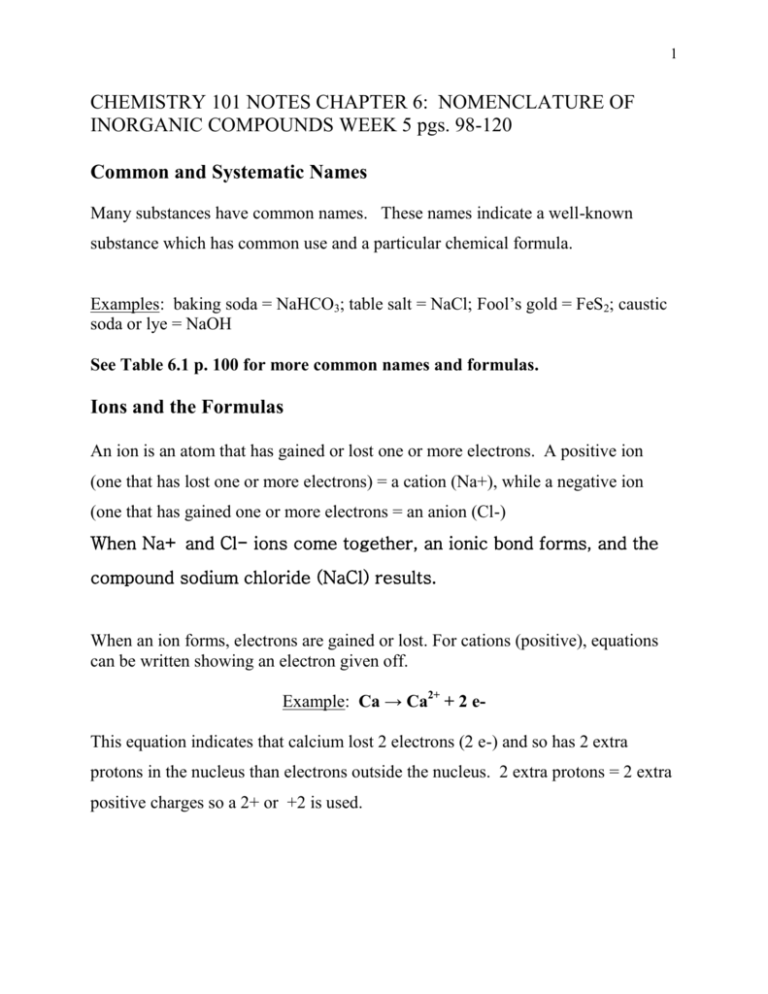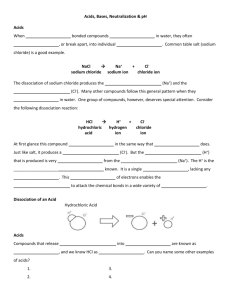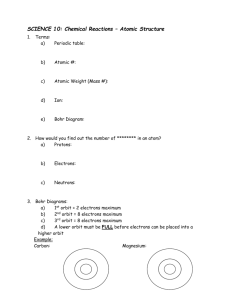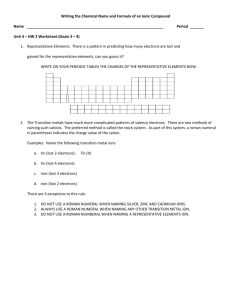CHEMISTRY 101 NOTES CHAPTER 6
advertisement

1 CHEMISTRY 101 NOTES CHAPTER 6: NOMENCLATURE OF INORGANIC COMPOUNDS WEEK 5 pgs. 98-120 Common and Systematic Names Many substances have common names. These names indicate a well-known substance which has common use and a particular chemical formula. Examples: baking soda = NaHCO3; table salt = NaCl; Fool’s gold = FeS2; caustic soda or lye = NaOH See Table 6.1 p. 100 for more common names and formulas. Ions and the Formulas An ion is an atom that has gained or lost one or more electrons. A positive ion (one that has lost one or more electrons) = a cation (Na+), while a negative ion (one that has gained one or more electrons = an anion (Cl-) When Na+ and Cl- ions come together, an ionic bond forms, and the compound sodium chloride (NaCl) results. When an ion forms, electrons are gained or lost. For cations (positive), equations can be written showing an electron given off. Example: Ca → Ca2+ + 2 eThis equation indicates that calcium lost 2 electrons (2 e-) and so has 2 extra protons in the nucleus than electrons outside the nucleus. 2 extra protons = 2 extra positive charges so a 2+ or +2 is used. 2 Conversely, when a negative ion forms (anion), electrons are gained. Example: S + 2e- → S22 extra electrons outside the nucleus than protons inside the nucleus are indicated by a 2- or -2. IMPORTANT: PROTONS ARE NEVER GIVEN OFF OR GAINED, ONLY ELECTRONS. TO DO SO WOULD CHANGE THE IDENTITY OF THE ELEMENT. THIS DOES NOT HAPPEN DURING CHEMICAL CHANGE. Naming Cations for Elements Cations for elements such as many metals are simply named using the name of the metal followed by the word “ion.” Example: Na+ would be named a sodium ion; Ca+2 would be named a calcium ion. Naming Anions for Elements When an element gains electrons (usually a non-metal such as oxygen), it is named using the prefix for the non-metal followed by the addition of the suffix –ide. Examples: N-3 would be named nitride (nitrogen – ogen + ide), not nitrogen; Brwould be named bromide (bromine – ine + ide.) See Table on p. 102 for more examples. 3 Predicting Charges Charges of some elements can be predicted knowing where the element is on the periodic table. For instance, Group IIA are all positive 2 as ions (2+); group VIA are all negative 2 as ions (2-) Figure 6.2 on pg. 103 gives more examples of this. Writing Formulas for Ionic Compounds Ionic compounds are those that contain ions. They are usually composed of a metal and non-metal. When dissolved in water, these compounds conduct electricity well and are termed strong electrolytes. A name for these compounds consists of naming the cation (positive) ion first followed by naming the anion (negative) ion second. Examples: sodium fluoride (used in toothpaste); calcium oxide (lime); calcium chloride (used to melt snow and ice) The formula for sodium fluoride would be NaF. Na+ + F- →NaF NOTE: When no number is given with a charge, the charge is understood to be 1. The formula for calcium oxide would be CaO. Ca+2 + O-2 → CaO The formula for calcium chloride would be CaCl2. Ca+2 + 2 Cl- → CaCl2 4 In the above example, it takes 2 Cl- ions to balance the charge of 1 Ca+2. -2 (from 2 Cl-) + +2 = 0. For a neutral compound, the charges must add to 0! Hence, it is often necessary as in the above example to use more than one ion in the formula to balance the charges. Suppose the formula for aluminum bromide was desired. If aluminum has a +3 charge (pg. 103), how many bromide ions are needed to balance it? Al+3 + 3 Br- ---> AlBr3 +3 (from 1 Al+3 + -3 (from 3 Br-)) = 0 Write the formula for the following using the given ions. a. Ca2+ and Brb. Ba2+ and O2c. Mg2+ and N3- Naming Binary (Containing Two Elements) Compounds Use name for the metal followed by the name of the non-metal – suffix + ide. Examples: NaF = sodium fluorine – ine + ide = sodium fluoride 5 BeS = beryllium sulfur – ur + ide = beryllium sulfide See Tables 6.2 and 6.3 in text for names of anions (negative ions) and examples of compound names ending in –ide. Naming Compounds Containing Transition Metals, Lead, Tin, and Other Ions That Can Have Different Positive Charges These compounds are named the same way except a Roman numeral may be used to indicate the charge. The Roman numeral is written in parentheses. For instance, copper can be +1 or +2 depending on the anion it is with. So, a Roman numeral (I) or (II) could be used in naming the compound. Example: CuCl would be named copper (I) chloride while CuCl2 would be named copper (II) chloride. The Roman numeral can be determined by first figuring out the total negative charge and then dividing that charge by the subscript for the positive ion (often a metal). Roman Numerals (starting with one): SOMETIMES INSTEAD OF USING ROMAN NUMERALS, THE CLASSICAL (OFTEN LATIN) NAME OF THE METAL ION IS USED. See Table 6.4 pg. 107 for these names. Example: Cu1+ is named cuprous, while Cu2+ is named cupric. 6 So, CuCl would be named cuprous chloride, while CuCl2 would be named cupric chloride. Naming Compounds That Contain 2 Non-Metals Bonded to Each Other The bond formed between 2 non-metals is termed a covalent bond. COVALENT COMPOUNDS ARE NAMED USING PREFIXES. THE NUMBER OF ATOMS OF AN ELEMENT INDICATE THE PREFIX USED IN ITS NAME. Prefixes for 1-10: CO = carbon monoxide, not monocarbon monoxide. If one element is present first in the name, no prefix is used! Note that the –ide suffix is used here also. SO2 = sulfur dioxide; CCl4 = carbon tetrachloride N2O3 = dinitrogen trioxide; Cl2O7 = dichlorine heptoxide: NOTE: The a in hepta is dropped as the o- would be next to another vowel –a. Cl2S7 would be named a heptasulfide (the vowel, a, is not dropped in this case). 7 Naming Binary Acids Acids are compounds that contain hydrogen and often another non-metal in which the hydrogen separates to form hydrogen ion (H+). A negative ion results as well. Binary acids in which hydrogen and another element are present are named using the prefix “hydro-“followed by the name of the other element in which the suffix –ic has been added. EXAMPLES: HBr would be named hydrobromic acid. H2Te would be named hydrotelluric acid. See Handout for Names of Binary Acids and pg. 110. Naming Polyatomic Ion Containing Compounds See Handout for a List of Polyatomic Ions and Table 6.6 pg. 117. These compounds are named similarly to binary compounds except the name of a polyatomic ion is used in place of an elemental anion (negative ion) or in a few cases cations (positive ions). 8 EXAMPLES The compound formed by sodium ions (Na+) and phosphate ions (PO4-3) would be Na3PO4. There is a subscript 3 with the Na because it takes three +1 charges to cancel one -3 charge. It would be named sodium phosphate. KMnO4 = potassium permanganate KClO3 = potassium chlorate K2SO4 = potassium sulfate NH4Cl = ammonium chloride H2CO3 = hydrogen carbonate OR CARBONIC ACID HClO3 = hydrogen chlorate OR CHLORIC ACID NOTE: HCl would be named hydrochloric acid; as no oxygen is present in the formula, it is NOT a polyatomic ion containing compound.








